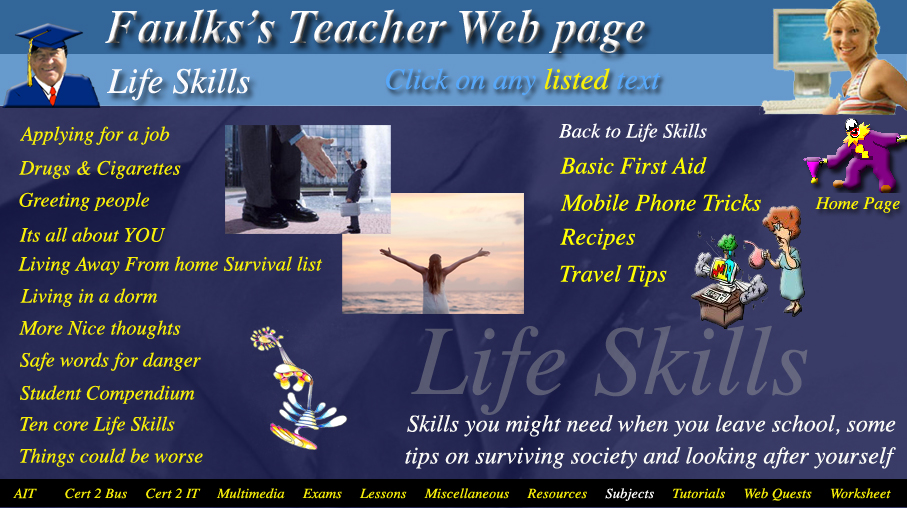



Some knowledge of basic
first aid could mean the difference between life and death.
Consider doing a first aid
course, so that you will be able to manage if someone is injured or becomes
ill.
CPR is a life-saving skill
that everyone should learn.
CPR stands for Cardio Pulmonary Resuscitation. Its an emergency procedure performed in an effort to manually preserve intact brain function until further measures are taken to restore spontaneous blood circulation and breathing in a person in cardiac arrest. Cardio = Heart Pulmonary = Lungs Resuscutation = Revival

Keep a range of first aid
kits handy at home, in the car and at work.

1.
Stop
Bleeding. Apply direct pressure on the cut or wound with a clean cloth, tissue, or piece
of gauze until bleeding stops. ...
2.
Clean Cut or Wound. Gently clean with soap and warm
water. ...
3.
Protect
the Wound. Apply antibiotic cream to reduce risk of infection and cover
with a sterile bandage. ...
4.
Get
a small Ice Pack and keep it in the freezer, use over cuts or injuries
5.
Keep
2 finger plasters in your wallet or purse.

The DRSABCD action plan
If you have completed a first aid course, you will be familiar with the DRSABCD action plan.
Each letter is a prompt for the actions to take when first aid is needed.
DRSABCD ACTION PLAN



A
basic first aid kit may contain:
Plasters in a variety of different sizes and shapes
Small, medium and large sterile gauze dressings
At least 2 sterile eye dressings
Triangular bandages
Crêpe rolled bandages
Safety pins
Disposable sterile gloves
Tweezers
Scissors
Alcohol-free cleansing wipes
Sticky tape
Thermometer (preferably digital)
Skin rash cream, such as hydrocortisone or calendula
Cream or spray to relieve insect bites and stings
Antiseptic cream
Painkillers such as paracetamol (or infant paracetamol for children), aspirin (not to be given to children under 16), or ibuprofen
Cough medicine
Antihistamine cream or tablets
Distilled water for cleaning wounds
Eye wash and eye bath
It
may also be useful to keep a basic first aid manual or instruction booklet with
your first aid kit.
Medicines
should be checked regularly to make sure they're within their use-by dates.

Medications are very unpredictable. Many medications or illicit drugs have dangerous side effects, particularly if they are mixed together or taken with alcohol.
If you are aware or suspect that someone you have found has overdosed on drugs or medications, do not leave them to ‘sleep it off’.A doctor or ambulance paramedic should assess any person who overdoses on any medication.
It is very important that you call triple zero (000) or the emergency number in that country, if you are aware or suspect that someone you have found has overdosed on drugs or medications, as many overdoses cause death.
Open wounds are prone to infection. Suggestions to reduce the risk of infection include:
Wash your hands if possible
before managing the wound. You could also use an antibacterial hand sanitiser.
Put on the disposable gloves
provided in your first aid kit.
Try to avoid breathing or
coughing over the wound.
Cleaning of the wound
depends on the type and severity of the wound, including the severity of the
bleeding. You may just clean around the wound.
Cover the wound with a
sterile dressing. Try not to touch the dressing’s surface before applying it to
the wound.
Seek medical advice or call
triple zero (000) for an ambulance.
In an emergency, these suggestions may not be
practical. If the injured person is bleeding heavily, don’t waste time. For
example, cleaning the wound might dislodge a blood clot and make the wound
bleed again or bleed more.
Immediately apply pressure to a heavily bleeding
wound (or around the wound if there is an embedded object), and apply a bandage
when the bleeding has slowed down or stopped. Call triple zero (000)
immediately.
After being bandaged, an injured forearm or wrist may require an arm sling to lift the arm and keep it from moving. Steps include:
Arrange the person’s arm in
a ‘V’ so that it is held in front of their body and bent at the elbow, with the
hand resting in the hollow where the collarbone meets the shoulder.
Open a triangular bandage
and place it on top of the injured arm. The longest edge needs to be lengthwise
along the person’s body and the point of the bandage should be towards the
person’s elbow on their injured side. You only need enough material to tie a
knot at the fingertip end.
Create a cradle (hammock)
around the injured arm by folding the upper half of the long edge under the
injured arm.
Gently gather the material
together at the elbow and pull it tight without pulling the bandage off the
injured arm. Twist the material into a long spiral.
Bring the long spiral around
and then up the person’s back.
Tie the two ends together
firmly at the person’s fingertips.
In an emergency, always call
triple zero (000)
Your doctor
The emergency department of
your nearest hospital
St John Ambulance Australia
(Victoria) for first aid and CPR courses Tel. 1300 360 455
Australian Red Cross for
first aid and CPR courses Tel. 1300 367 428
here are some documents to help get through life...
Also take a look at the Student Survival kit, if off to Uni or College
need more? Try the Student Compendium for a list of useful information
| Life Skills 101 | A document covering how to survive in the outside world |
| LFS100 The Boxes of Life | Life moves through a series of changes we call these the boxes of life |
| LFS101 Avoiding Starvation | Easy recipes |
| LFS102 Basic First Aid | How to treat basic injuries |
| LFS103 Cigarettes or $10,000 | How to become better off not smoking |
| LFS104 Having a booze up | How to have a real drink without getting drunk! |
| LFS105 Your First Dinner Date | Know your food and wines |
| LFS106 Mobile Phone Tricks | Dial 112 in an emergency |
| LFS107 Tips about Airports and Flying | Wear loose clothing and a scarf |

![]()
Words to help you through life
Basic Files to help with life at University or College |
|
| Create Crossword | |
| Glossary for Exams | Words used in Exam questions |
| Glossary Technology Exams | Technical term IT Exams |
| Grammar and syntax | |
| How to answer Exam questions | |
| How to writes a resume | Resume Basic |
| Job Application Notes | Resume Executive |
| JOHN CLEESE on English | |
| Nouns_and_Adjectives | |
| Personality Test | |
| Table maze | |
| The Chinese New Year Game | |
| Things to do chart | |

![]()
Applied Information Technology * AITStage1 * AITStage2 * AITStage3 * Cert II Business * Cert II Information Technology * Multimedia
Subjects * Art * Computing * English * Geography * Hass * History * Mathematics
Miscellaneous * Acronyms * Accreditation * ICT_Homework * Naplan * Lessons * Quizzes * Relief Lessons * Proverbs * Sayings * Simile
Exams & Tests * Student Survival Kit * Web quests * Worksheets * Home Page * Peters Site * Soccer
![]()
| Filemaker | ||||||||
 |
||||||||
| SoundBooth | ||||||||

Email Peter Faulks
Applied Information Technology * AITStage1 * AITStage2 * AITStage3 * Cert II Business * Cert II Information Technology * Multimedia
Subjects * Art * Computing * English * Geography * Hass * History * Mathematics
Miscellaneous * Acronyms * Accreditation * ICT_Homework * Naplan * Lessons * Quizzes * Relief Lessons * Proverbs * Sayings * Simile
Exams & Tests * Student Survival Kit * Web quests * Worksheets * Home Page * Peters Site * Soccer

Page last updated 23rd April 2020
© Peter J Faulks